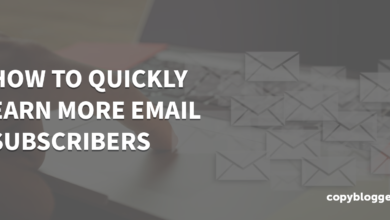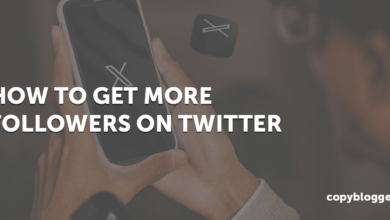15 Personal Branding Examples To Learn From

Some people consistently earn hundreds of likes and comments on each of their posts, and their audiences have helped them achieve financial freedom and security.
However, they all started with no network and zero followers.
So what actions did they take to achieve this success?
In this post, I’ll share 15 outstanding personal branding examples and break down their strategies to build successful personal brands so you can use the same process to achieve similar results.
Want us to
scale your traffic?
For the first time, The Copyblogger methodology is now available to a select few clients. We know it works. We’ve been doing it since 2006.
3 Things All Strong Personal Brands Have In Common
As I analyzed these individuals with strong personal brands, I noticed that all their strategies have three key things in common.
While there are many ways to build a personal brand, implementing these three commonalities into your personal branding strategy will significantly increase your likelihood of success.
Consistency
Every person on this list posted content consistently for an extended period of time (i.e., posted content 2-5 times per week for several years).
A consistent publishing schedule is essential to build your personal brand for a few different reasons:
- It takes time to find your own brand identity and voice.
- It takes time to build trust and a genuine relationship with your target audience.
- It takes time to find audience-content fit (i.e., content that your audience likes and that you enjoy creating).
Therefore, even if you don’t think your initial content is very good, publish it to start gathering data and figure out what you enjoy creating and what resonates with your audience. You’ll also get better at creating content by publishing more.
Target A Single Niche
Another commonality I noticed among these individuals with great personal brands is that they all focus on a specific niche.
A key mistake many creators make is discussing too many different topics or expanding into other niches. While it may be boring to talk about one specific niche, the reality is that your audience probably follows you because they enjoy learning about that specific topic you cover.
For example, if you talk about digital marketing, NFTs, and solopreneurship, there’s a good chance that the people interested in digital marketing won’t be interested in your NFT content. As a result, you’ll find it difficult to build a loyal audience that loves all of your content.
Additionally, most people are only experts on one topic, so choose the niche you feel you know best.
However, if you want to post content related to your personal life and growth, this content can make you more relatable and strengthen your relationship with your audience.
As a general rule, make about 80% of your posts related to a specific topic, and then the other 20% of posts can be about your personal life or interests.
Share Real Experiences
Many readers don’t enjoy blog posts written primarily for SEO because these posts often lack personal experience. In fact, many people now turn to ChatGPT for strictly factual information.
Sharing your personal experiences makes your content more relatable as your audience is likely facing challenges you’ve also faced, and they’d love to hear someone else’s perspective on how they approached and solved that problem.
Bonus: Choose A Primary Platform
Most large influencers today began by publishing content on just one platform.
Over time, many of them branched out to different content formats, but at that point, they usually had teams behind them to assist with content repurposing. If you’re beginning your personal branding journey and don’t have a team to help you repurpose your content, focus on just one platform.
Brett Williams is a designer who makes over $100,000 per month with his one-man design agency, DesignJoy, and $50,000 per month from a course on productizing service businesses.
Nearly all of his customers for both businesses come from his 70,000 followers on Twitter.
To grow his audience, Brett followed all of the best practice advice, like posting consistently, owning a specific niche, and sharing his authentic experience. However, he also shared a lot of revenue numbers.
Here’s just one example of the transparency he regularly shares around revenue numbers.

He is also a solopreneur, which is currently a trending topic.
So the combination of real revenue numbers around a trending topic helped him quickly build a large audience.
Codie Sanchez has built a strong personal brand in the entrepreneurship category. Specifically, she has established herself as an expert on buying boring businesses and has helped make that niche a trend.
Before focusing on building her personal brand, she had already built a portfolio of “boring” brick-and-mortar businesses. So when Cody decided to double down on building her social media presence, she already had capital to deploy and hired social media experts to help her repurpose the content across YouTube, Twitter, LinkedIn, and even a newsletter.
Today, she uses her audience as lead generation for her portfolio of businesses, and she also has a course that helps students identify and buy great “boring” businesses.
The key to her growth on social media likely comes down to a few things:
- She hires experts. She hired people like ex-YouTuber Jamie Rawsthorne to help her grow her YouTube channel, and she also hired people to help build her social media profiles. These experts already understand the nuances of how each algorithm works, making it easier to optimize the content for each platform and grow faster.
- She has unique experiences and shares them through excellent storytelling. Few people have worked on Wall Street and then built a portfolio of boring businesses, like car washes and laundromats. This experience gives her content unique context, which makes it more interesting.

- She had a strong personal network. While she was in the trenches building these businesses, she also built a strong network. Therefore, when she decided to double down on building her online presence, she already had a leg up. So meet more people in real life and build genuine connections by attending conferences, hosting your own events, or sparking thoughtful conversations in the comments on other people’s social media posts.
Chris Do is a designer and the CEO of The Futur, an online education platform whose mission statement is to teach 1 billion people how to make a living doing what they love.
Today, Chris has a strong online presence across multiple platforms, but his primary growth channel is Instagram.
He outlines the approach he used to grow to nearly one million organic Instagram followers in this video:
As you’ll hear in the video, Chris’s main strategy to grow his Instagram following was transforming his existing keynote presentations into fun, engaging carousels.
This arsenal of content made it easy for him to post consistently, because he just had to reformat it into carousels. Additionally, he had already tested these keynotes with live audiences and knew what did and did not resonate with them.
The main takeaway is to look at the content you already have that has resonated with your audience and then repurpose it into engaging content formatted for that platform.
Chase Dimond has built a strong follower base on LinkedIn, and there are a few key reasons why he’s been successful.
First, he positioned himself in a very specific niche. Rather than trying to compete in the larger marketing consultant niche, he established himself as an email marketing expert for ecommerce companies.
In fact, if you look at his LinkedIn profile, he has sent over a billion emails for ecommerce companies that have collectively generated over $150 million in attributed revenue.
As a result, any ecommerce owner struggling with email marketing will immediately identify him as a specialized expert who can solve their specific problem.
He also publishes daily on LinkedIn, and you can tell that his posts are very visual. In fact, rather than typing out text-based content, he just uses screenshots from Twitter. This helps the text jump out at scrollers and capture their attention.

Jon Youshaei is an ex-YouTube employee who left his job to build his own YouTube channel.
Today, he is a well-respected thought leader and has interviewed YouTube experts like MrBeast, Danny Duncan, and many other creators.

While Jon publishes fairly regularly, he publishes less often than some other creators on this list.
Instead, his fast growth is mainly due to the outstanding guests he has on his podcast.
If you want to grow your personal brand faster, consider collaborating with other influencers in your industry. Jon already had some connections from his time as an employee at YouTube, but you can always start by interviewing smaller influencers and then work your way up.
Ideally, target influencers that also share content they participate in creating, as that will help your content earn more reach.
Jon also puts a lot of effort into editing the podcast videos to make them more entertaining than a traditional conversation. If you plan to do content collaborations with other influencers, think about how you can make your interviews unique and entertaining.
Romana Hoekstra is a SaaS marketer who quickly built an impressive audience on LinkedIn.
While many of the creators on this list are founders of multi-million dollar businesses, Romana is a great example of a freelancer who has built a strong personal brand. So even if you don’t have a stack of impressive accolades, like a multi-million dollar exit, you can still establish yourself as an expert by niching down and consistently creating visually attractive and actionable content.
She was even named a top content marketing voice:

About 80% of her content is focused on content marketing for SaaS companies and the other 20% is related to her personal life, making her a relatable and interesting creator.
Romana also puts a lot of effort into creating visually appealing graphics.

Regardless of the social media channel you’re posting your content on, think about how you can make it more engaging and fun for people to consume.
Elena Verna is the Head of Growth at Dropbox and has mastered the art of balancing entertaining content, like memes, with thought-provoking ideas that interest other high-level executives.
Here’s just one example of a meme she shared recently that is funny to her target audience:

However, she also frequently posts thought-provoking, original content like this post:

While Elena certainly has an advantage as an executive at a major company, anyone can use her strategy of mixing memes with thought-provoking leadership content.
You’ll also notice that a lot of her content is observational. For example, rather than telling you her opinion, she shows you an interesting fact and then offers her analysis.
This is another great example of her “observational” style content:
If you don’t have anything interesting to share and are looking for content ideas, identify patterns and share them with your audience. Then, you can provide your observation on it.
Alex Hormozi’s personal brand blew up seemingly overnight.
He grew from just 180,000 to 1.2 million followers in just six months, and two main factors allowed him to achieve such rapid growth in such a short period.
First, he had already built several eight-figure businesses, so he had very unique (and valuable) personal experiences to share. Even if you don’t have experience building multiple eight-figure businesses, you can still create equally interesting content by either interviewing these experts or taking their advice, implementing it, and then documenting your results.
However, he also credits his rapid growth to his content repurposing strategy. He was originally only producing seven pieces of content per week, but his growth took off when he increased his content output to 80 pieces per week.
The best part is that he didn’t even increase the amount of content he created. Instead, he simply hired people to repurpose the content he was already producing across more platforms.

Justin Welsh has established himself as one of the most prominent solopreneurs on social media and has over 450,000 followers on Twitter and over 500,000 followers on LinkedIn.
He was previously an executive at a successful startup, and after getting burned out, he eventually built his own personal brand.
Justin revealed that he relies heavily on content repurposing and publishing workflows, as he believes consistency is essential for building a personal brand.
Here, he shows that he posted the same piece of content 12 days apart, and you can tell it performed very well both times.

Using templates prevents you from starting from scratch each time you create a piece of content, and you feel intimidated staring at a blank screen.

The key to building a strong personal brand really comes down to consistency, so consider creating content templates to make it easier to create content. This way, you won’t waste time staring at a blank screen as you won’t have to start from scratch each time you create a piece of content.
Jay Clouse quit his job to become a full-time creator and has grown his social media following to over 35,000 followers on LinkedIn and over 40,000 followers on Twitter.
He is also a top voice on LinkedIn and earns over $50,000 per month as a solo creator.
He recently revealed exactly how he would focus on building an audience in 2024, and here’s the step-by-step process he recommends:
- Choose one word or catchphrase to be associated with. For example, Nick Huber is known for “sweaty startups,” whereas James Clear is known for building small habits.
- Create a free email course. An email course will help you build a deeper relationship with your readers, and unlike on social media, where you depend on an algorithm to show them content, you own the audience. Email subscribers have also permitted you to be in their inbox, so you’ll probably have a deeper relationship with them.
- Choose a discovery platform. Similar to the advice I mentioned at the beginning of this post, Jay recommends that you double down on one platform (YouTube, Twitter, etc.).
- Design your social media profile to align with your premise. Whatever you choose to be known for, optimize your tagline and personal brand statement to speak to your target audience. The most effective personal brand statements are clear, concise, and make it obvious what kind of value you provide.
- Study, study, study. Whatever you choose to be known for, aim to become an expert on that topic so you provide the most helpful advice possible.
You can read his full step-by-step guide on building a personal brand, but those are the main steps to get started.
Jay also does interview-based videos with top creators, and leveraging their audiences has helped accelerate his growth. He is also a master at content promotion and creates mini-trailers of the interviews, which he then promotes on social media.

Ross Simmonds has over 65,000 followers on Twitter and is known as an influencer in SaaS marketing.
He has an impressive content publishing frequency and Tweets several times per day, and he revealed in the post below that he also relies heavily on content repurposing and republishing.

Most of his posts include helpful tips SaaS companies can use to improve their marketing strategies, but he also includes the occasional personal/philosophical post to keep his content relatable and personal.

Ross also creates many different types of social media content. For example, while most people only post text-based Tweets, Ross frequently posts graphics and even video content on Twitter.
If video content is your primary content format, you can easily repurpose them into short clips or even hire a copywriter to repurpose snippets of it into written content formats.
Unlike other influencers on this list, Noah Kagan has steadily built his personal brand over the past decade and didn’t use a single platform to build his audience.
Instead, he hosted in-person events, attended conferences, and made a real effort to build personal connections with people in real life.
As many of these people he met leveled up in their careers, these personal relationships have helped him grow on social media. For example, he recently launched a book and is well on his way to becoming a bestselling author, as his friends all pitched in to help promote it.

The main takeaway you can learn from Noah is that sometimes the best way to grow an audience is to meet people in real life, provide value, and cheer for them when they win.
He has also consistently posted content on his podcast, YouTube channel, and social media accounts for over a decade, so have a long-term mindset as you build your personal brand.
Nick Huber has risen to Twitter fame thanks to his unique niche (storage sheds) and the occasional controversial and/or uncomfortable statement.

Unlike most tech entrepreneurs, he stands out as a down-to-earth, country person, which makes him unique and fits his brand nicely.
Think about your unique interests and hobbies and then weave them into your content marketing strategy.

If you don’t feel that you fit in with the traditional tech entrepreneur mold, embrace your unique characteristics, because they will actually help you stand out.
Kevin Espiritu runs the largest YouTube channel on gardening. He began as a blogger and eventually transitioned to YouTube as his primary platform.
After switching to YouTube, he became the face of the channel and eventually began building his personal brand in the broader entrepreneur community.
Today, he regularly shares content on Twitter about his experience as a top player in the creator economy.
However, unlike many other solopreneurs and influencers on this list, Kevin doesn’t have a specific content framework or strategy for his personal brand. He purposefully writes on his Twitter biography that his Tweets are mainly notes to himself.

If you’re struggling to think of content ideas, write about anything you’ve recently discovered that you find interesting. If you find something interesting, there’s a good chance other people will also find it interesting, and as a result, you’ll grow a following.
Alex Lieberman is a co-founder of the popular newsletter Morning Brew. Yet today, he’s best known as a content creator and regularly creates content around entrepreneurship, the creator economy, and business ideas.
A key reason Alex is such a successful content creator is that he’s great at sharing his personal struggles and experiences.
For example, he openly shared about his failure with a backyard game he began after leaving Morning Brew.

He also shares about random wild things that he has done, like getting free tickets to a sporting event from HubSpot:

If you’re posting primarily instructional content, think about how you can post more experiential-style content so that you seem more relatable.
Start Building Your Personal Brand Today
As you can see, there are many different ways to build a personal brand, but finding your niche and voice can be challenging.
To help you navigate the challenge of personal branding, we created the Copyblogger Academy, a community of solopreneurs and content creators building personal brands. You’ll also have access to courses on personal branding and direct feedback from the team behind Copyblogger and top personal branding experts.
If you want to invest in yourself and take your first step towards financial freedom, try the Copyblogger Academy today.





